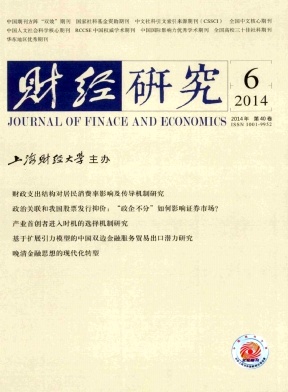产业首创者进入时机的选择机制研究
财经研究 2014 年 第 40 卷第 06 期, 页码:38 - 47
摘要
参考文献
摘要
文章通过建立一个两企业博弈模型,分析了产业首创企业进入时机的选择机制。分析得出的主要结论是:(1)当后动优势占优时,企业进入时机的选择并不必然依赖于企业自身资源,产业首创者反而更可能是企业自身资源相对较弱者;(2)虽然产业发展潜力及预期利润对产业首创者的进入具有正向促进作用,但是该促进作用随后动优势的增加而减小。文章利用1998-2007年中国工业企业数据,对结论(1)进行了实证检验,并支持该结论。最后文章提出了产业产生时机的概念,并提出了相应的政策建议。
[1]曹玉书,楼东玮.资源错配、结构变迁与中国经济转型[J].中国工业经济,2012,(10):5-18.
[2]郭晓丹,宋维佳.战略性新兴产业的进入时机选择:领军还是跟进[J].中国工业经济,2011,(5):119-128.
[3]汤姆森,迪斯克兰德.战略管理——概念与案例[M].北京:北京大学出版社·科文(香港)出版有限公司,2000:184-185.
[4]张维迎.博弈论与信息经济学[M].上海:格致出版社·上海三联书店·上海人民出版社,2012.
[5]朱·弗登博格,让·梯若尔.博弈论[M].北京:中国人民大学出版社,2010.
[6]Bayus B L,Agarwal R.The role of pre-entry experience,entry timing,and product technology strategies in explaining firm survival[J].Management Science,2007,53(12):1887-1902.
[7]Boulding W,Christen M.Sustainable pioneering advantage?Profit implications of market entry order[J].Marketing Science,2003,22(3):371-392.
[8]Fuentelsaz L,Gomez J,Polo Y.Followers entry timing:evidence from the Spanish banking sector after deregulation[J].Strategic Management Journal,2002,23(3):245-264.
[9]Golder P N,Tellis G J.Pioneer advantage:Marketing logic or marketing legend?[J].Journal of Marketing Research,1993,30:158-170.
[10]Ji Li,Lam K C K,Karakowsky L,Gongming Qian.Firm resource and first mover advantages:A case of foreign direct investment(FDI)in China[J].International Business Review,2003,12(5):625-645.
[11]Kalayanaram G,Robinson W,Urban G.Order of market entry:Established empirical generalizations,emerging empirical generalizations,and future research[J].Marketing Science,1995,14(3):212-221.
[12]Kerin R A,Varadarajan P R,Peterson R A.First-mover advantage:A synthesis,conceptual framework,and research propositions[J].Journal of Marketing,1992,56(Oct.):33-52.
[13]Lieberman M B,Montgomery D B.First mover advantages[J].Strategic Management Journal,1988,9(S1):41-58.
[14]Lopez L E,Roberts E B.First-mover advantages in regimes of weak appropriability:The case of financial services innovations[J].Journal of Business Research,2002,55(12):997-1005.
[15]Robinson W T,Fornell C,Sullivan M.Are market pioneers intrinsically stronger than later entrants[J].Strategic Management Journal,1992,13(8):609-624.
[16]Robinson W T,Fornell C.Sources of market pioneer advantages in consumer goods industries[J].Journal of Marketing Research,1985,22(Aug.):305-317.
[17]Schoenecker T S,Cooper A C.The role of firm resources and organizational attributes in determining entry timing:A cross-industry study[J].Strategic Management Journal,1998,19(12):1127-1143.
[18]Tran V D,Sibley D S,Wilkle S.Second mover advantage and entry timing[J].The Journal of Industrial Economics,2012,60(3):517-535.
①由于我们事先并不知道谁是产业首创者,因此,对整个产业而言,产业首创者可能是企业1,可能是企业2,也可能是企业1、企业2同时进入。产业首创者进入的概率即为至少有一个企业进入的概率。至少有一个企业进入的概率=1-两企业都不进入的概率。
②在该模型中,企业1或企业2的进入时间t就是,企业1或企业2在观察到无企业进入时,作为第一位进入者的进入时间。为了读者更好地理解该模型,本文认为有必要指出这一点。
①1998-2002年采用1994年的行业分类标准,2003-2007年采用2002年的行业分类标准。因此本文样本在2003年之前为通信终端设备制造业,行业代码为4113。从2003年开始包括通信终端设备制造业和移动通信终端设备制造业两部分,行业代码为4013和4014。
①结论1为,若k/γ>0,由γ1>γ2,k1>k2,得F1(t)
①1998-2002年,包括两位数行业代码为41,并扣除掉三位数行业代码414及418下的企业;2003-2007年,包括两位数行业代码为40,并扣除掉三位数行业代码为404下的企业。具体包括的行业可参见《高技术产业统计年鉴》。
[2]郭晓丹,宋维佳.战略性新兴产业的进入时机选择:领军还是跟进[J].中国工业经济,2011,(5):119-128.
[3]汤姆森,迪斯克兰德.战略管理——概念与案例[M].北京:北京大学出版社·科文(香港)出版有限公司,2000:184-185.
[4]张维迎.博弈论与信息经济学[M].上海:格致出版社·上海三联书店·上海人民出版社,2012.
[5]朱·弗登博格,让·梯若尔.博弈论[M].北京:中国人民大学出版社,2010.
[6]Bayus B L,Agarwal R.The role of pre-entry experience,entry timing,and product technology strategies in explaining firm survival[J].Management Science,2007,53(12):1887-1902.
[7]Boulding W,Christen M.Sustainable pioneering advantage?Profit implications of market entry order[J].Marketing Science,2003,22(3):371-392.
[8]Fuentelsaz L,Gomez J,Polo Y.Followers entry timing:evidence from the Spanish banking sector after deregulation[J].Strategic Management Journal,2002,23(3):245-264.
[9]Golder P N,Tellis G J.Pioneer advantage:Marketing logic or marketing legend?[J].Journal of Marketing Research,1993,30:158-170.
[10]Ji Li,Lam K C K,Karakowsky L,Gongming Qian.Firm resource and first mover advantages:A case of foreign direct investment(FDI)in China[J].International Business Review,2003,12(5):625-645.
[11]Kalayanaram G,Robinson W,Urban G.Order of market entry:Established empirical generalizations,emerging empirical generalizations,and future research[J].Marketing Science,1995,14(3):212-221.
[12]Kerin R A,Varadarajan P R,Peterson R A.First-mover advantage:A synthesis,conceptual framework,and research propositions[J].Journal of Marketing,1992,56(Oct.):33-52.
[13]Lieberman M B,Montgomery D B.First mover advantages[J].Strategic Management Journal,1988,9(S1):41-58.
[14]Lopez L E,Roberts E B.First-mover advantages in regimes of weak appropriability:The case of financial services innovations[J].Journal of Business Research,2002,55(12):997-1005.
[15]Robinson W T,Fornell C,Sullivan M.Are market pioneers intrinsically stronger than later entrants[J].Strategic Management Journal,1992,13(8):609-624.
[16]Robinson W T,Fornell C.Sources of market pioneer advantages in consumer goods industries[J].Journal of Marketing Research,1985,22(Aug.):305-317.
[17]Schoenecker T S,Cooper A C.The role of firm resources and organizational attributes in determining entry timing:A cross-industry study[J].Strategic Management Journal,1998,19(12):1127-1143.
[18]Tran V D,Sibley D S,Wilkle S.Second mover advantage and entry timing[J].The Journal of Industrial Economics,2012,60(3):517-535.
①由于我们事先并不知道谁是产业首创者,因此,对整个产业而言,产业首创者可能是企业1,可能是企业2,也可能是企业1、企业2同时进入。产业首创者进入的概率即为至少有一个企业进入的概率。至少有一个企业进入的概率=1-两企业都不进入的概率。
②在该模型中,企业1或企业2的进入时间t就是,企业1或企业2在观察到无企业进入时,作为第一位进入者的进入时间。为了读者更好地理解该模型,本文认为有必要指出这一点。
①1998-2002年采用1994年的行业分类标准,2003-2007年采用2002年的行业分类标准。因此本文样本在2003年之前为通信终端设备制造业,行业代码为4113。从2003年开始包括通信终端设备制造业和移动通信终端设备制造业两部分,行业代码为4013和4014。
①结论1为,若k/γ>0,由γ1>γ2,k1>k2,得F1(t)
①1998-2002年,包括两位数行业代码为41,并扣除掉三位数行业代码414及418下的企业;2003-2007年,包括两位数行业代码为40,并扣除掉三位数行业代码为404下的企业。具体包括的行业可参见《高技术产业统计年鉴》。
引用本文
靳来群, 林金忠. 产业首创者进入时机的选择机制研究[J]. 财经研究, 2014, 40(6): 38–47.
导出参考文献,格式为:





 6202
6202  3564
3564

